Top 10 baits from Lake Havasu
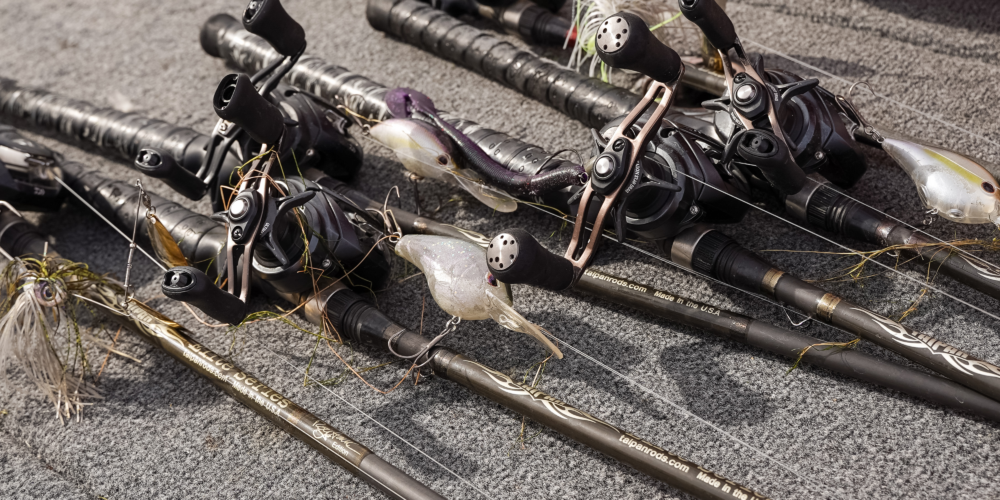
LAKE HAVASU CITY, Ariz. — A rare postspawn visit to Lake Havasu allowed the Western Division Presented by Tackle Warehouse anglers to take their pick on how they wanted to fish. Everything from shallow-water power tactics to deep finesse offerings, from glide baits to finesse worms, made an appearance in the Top 10 of the Toyota Series Presented by Phoenix Boats event.
The biggest theme seemed to be the importance of local knowledge. Half of the Top 10 lives within about three hours of the lake (close by Western standards), with Roy Hawk earning the win thanks in large part to his voluminous bank of waypoints on the lake.
Here’s how the Top 10 pros got it done.
1. Hawk rides his strength for the win
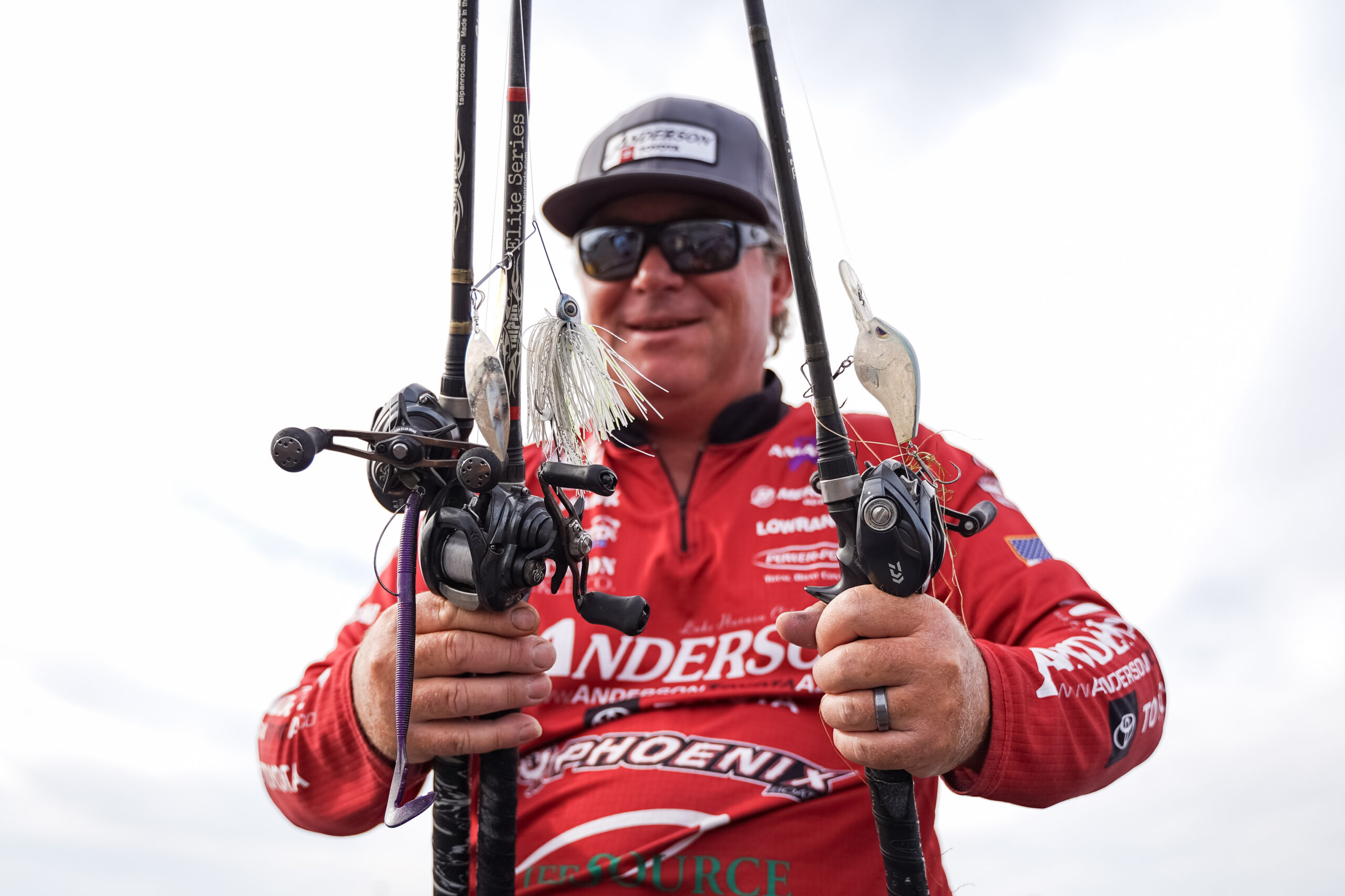
Hawk not only felt at home because he was fishing local waters, but because he did so using his favorite tool, a crankbait. The Lake Havasu City native said he rotated between six or seven different plugs with different diving depths and actions. The primary determinant for which one he threw was depth, as he bounced between offshore cover like brushpiles and cages as well as a shallower grass line.
“I’d fish inside grass and then outside fish habitat, structure out there — a little bit of both, kind of going in and out,” Hawk said. “Every once in a while, you’d get bit out, then I’d run a bunch of out stuff, get no more bites, go back in, get a bite in, then no more bites. So I was in and out a lot.”
Hawk threw the crankbaits on his Roy Hawk Signature Series Crankbait rod from Taipan, which he paired with Daiwa reels spooled with Daiwa J-Fluoro. He also mixed in a Texas-rigged Yamamoto Speed Senko. Combining the one-two punch with his knowledge of productive postspawn haunts made him the only competitor to eclipse 18 pounds all three days of competition.
2. Melton sight-fishes with eyes and electronics
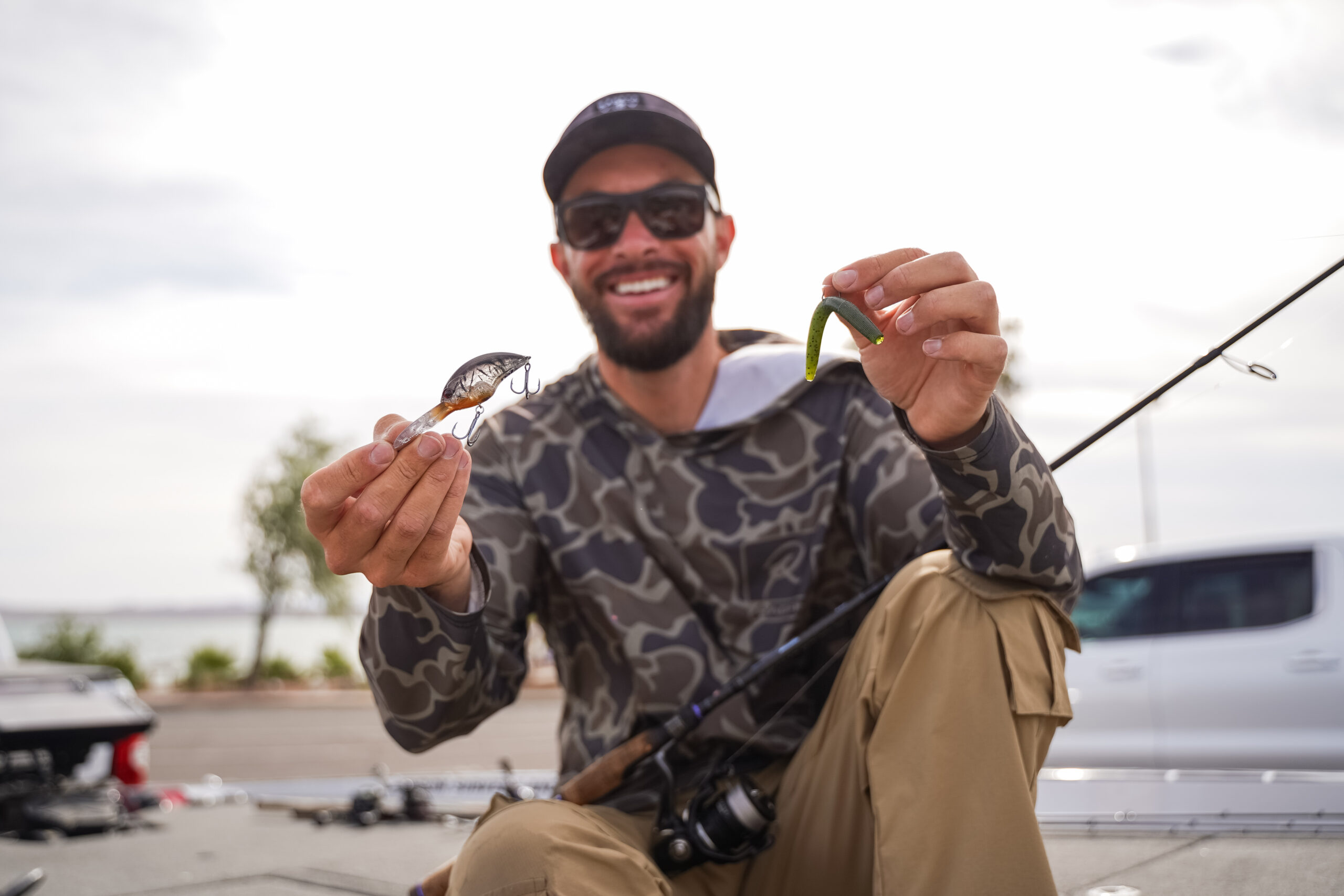
Cristian Melton gave Hawk a run for his money across the final two days, and while he didn’t claim his first professional win, he did take over the top spot in the Fishing Clash Angler of the Year race. He did it by locating a few shallow “honey holes” on the south end of the lake. Thanks in part to his previous visits to Havasu, Melton found a handful of key spots where the river channel met a bay and, he believes, bass were in all three phases of the spawn.
“It was just like these little honey holes,” Melton said. “You’d go through so much dead water, and wherever the main channel would hit a bay, it seemed like I found all three, the prespawn, spawn and postspawn.”
Melton caught a few fish with a Money crankbait — a mid-depth offering from 1776 Baits — in the convict craw color, particularly in the mornings. He did most of his damage pitching a wacky-rigged worm to fish he could see, either with his eyes or his electronics. When the sun got high in the sky, Melton used his Oakley shades to spot fish bedding and cruising, and he caught them with both a 4-inch Yamamoto senko and a thin senko in green pumpkin. He returned to those fish that wouldn’t eat on Day 1 and used his forward-facing sonar to make presentations to them from farther away. That seemed to produce bigger bites, as he sacked up 20-15 on Day 2 (the biggest bag of the event) and 18-0 on Day 3.
“I kind of tracked these little areas, these little hot zones, and I kind of anticipated these fish being there, and I would look at my live imaging,” Melton said. “It’s hard to make them out, because there’s so many carp and redear and stuff, but you’d end up making the cast over the right fish, and that’s what paid off for a couple big ones.”
3. Lassagne leans on finesse game
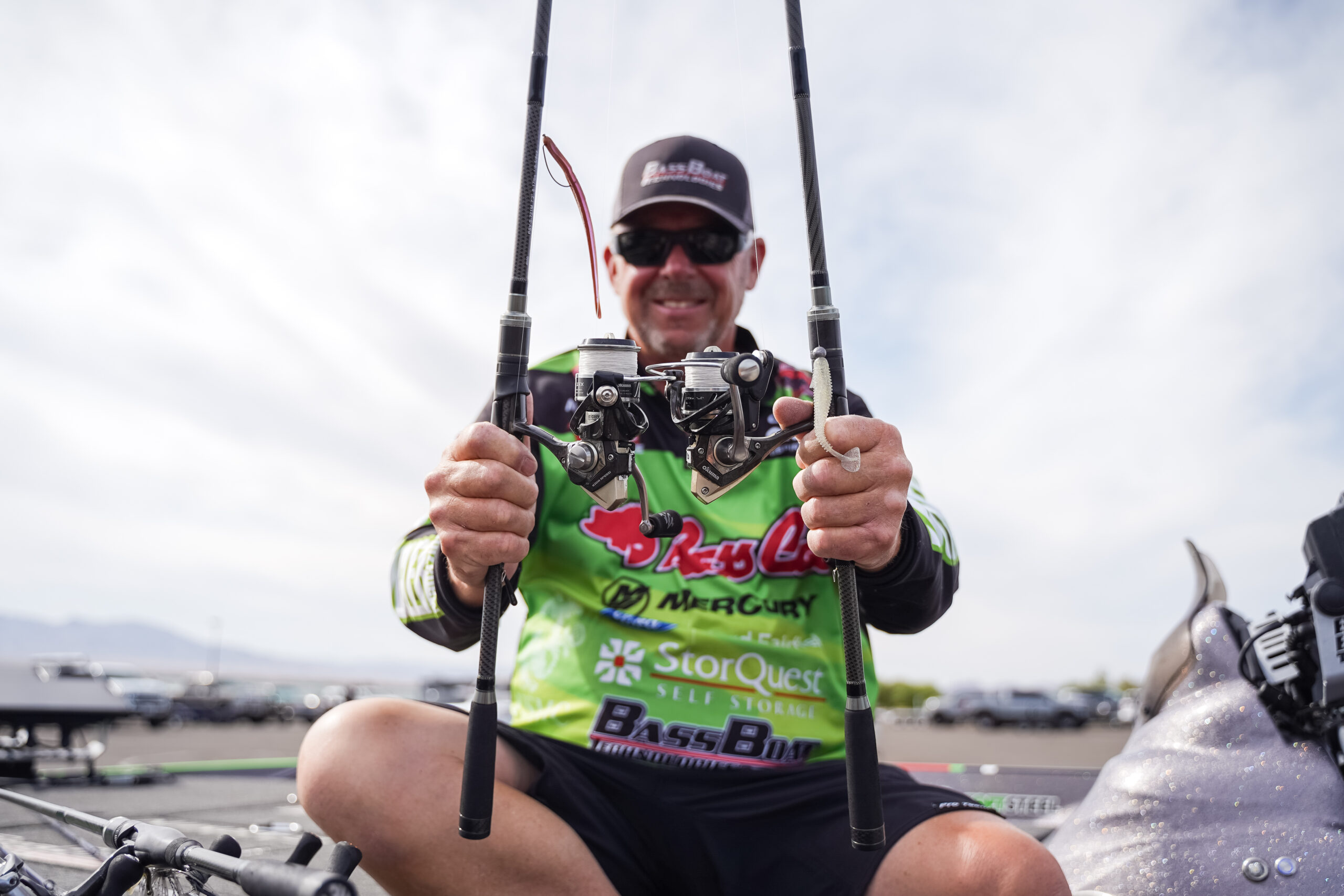
The leader after Day 1, Mark Lassagne notched his fourth Toyota Series Top 10 in the past five years by targeting main-lake points in 8 to 15 feet of water. While he primarily sought postspawn largemouth, he also plucked a few smallmouth, which he believes were on spawning beds.
“You’d find like a big flat, a big area where the fish would spawn, and then you’d look to see where they would move out to, and those would be the points on the outside edges, off the flats,” Lassagne said. “Kind of the double whammy to it is there was a few fish still spawning, and smallmouth spawn on points in the main lake, especially the later ones. So I think a couple of the smallmouth I got were ones that were actually spawning, whereas the largemouth were postspawn fish.”
Lassagne used finesse tactics to ply those points but changed baits each day. On Day 1, he sacked 20-9 primarily on the strength of a 3.3-inch Keitech Swing Impact Fat swimbait in sexy shad affixed to a 3/16-ounce ballhead. Finding the fish more finicky on the second day, he switched to a drop-shot, which he made with a 3/16-ounce weight, a Gamakatsu EWG hook and a 6-inch Roboworm straight tail worm in the M.M. III color. Finally, on Day 3, he switched to a Ned rig using a Z-Man TRD TicklerZ in the deal affixed to a 3/16-ounce mushroom head.
Lassagne threw all three baits on Okuma Psycho Stick spinning rods paired with Okuma ITX 3000 reels.
“The key was just being slow and methodical for me,” he said.
4. Grover uses textbook postspawn game plan
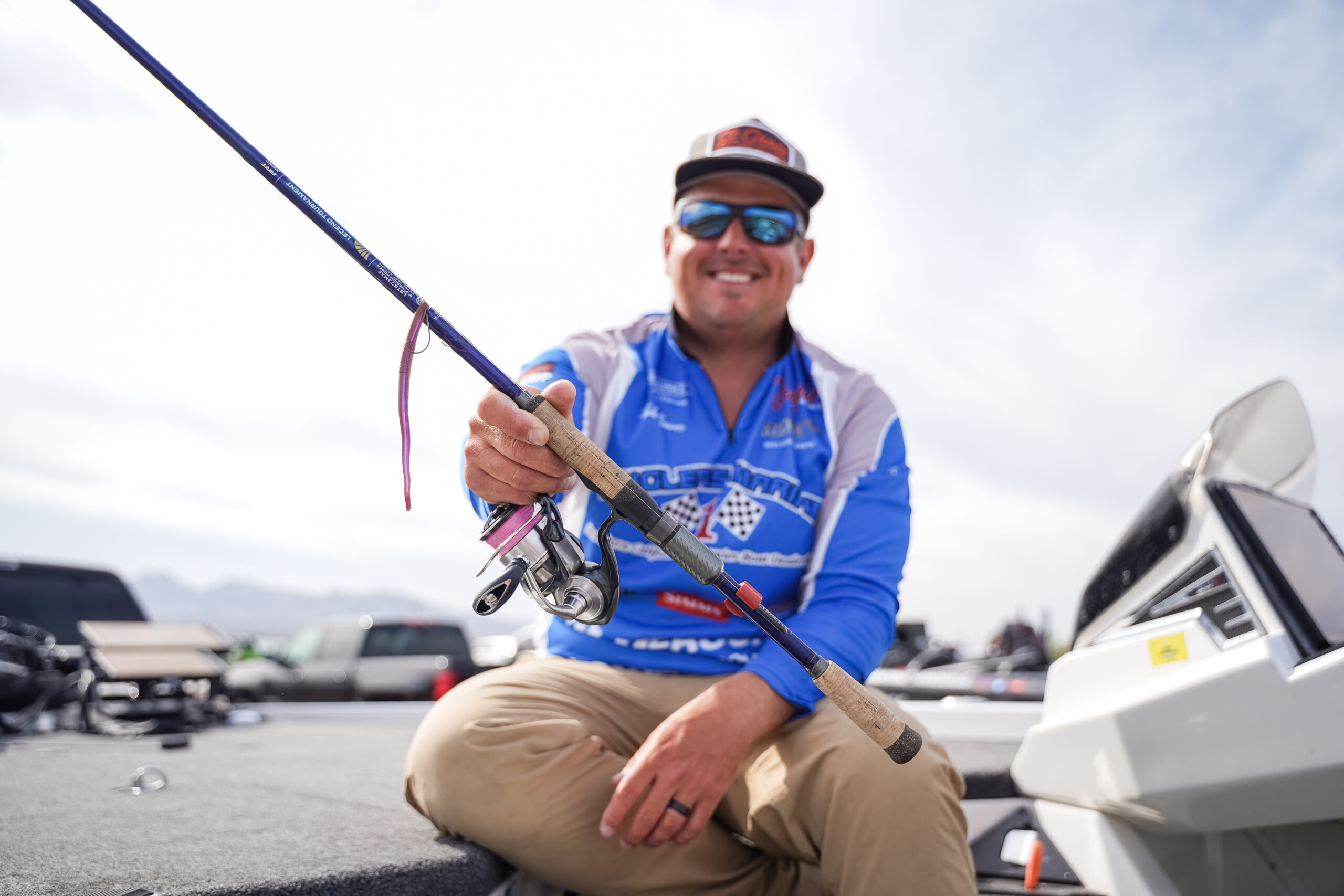
Kyle Grover topped 50 pounds for the event by targeting postspawn largemouth offshore on the main lake. He used a typical West Coast approach to catch them, throwing a drop-shot at the artificial habitat that has been sunk around the lake.
Grover affixed a 6-inch Roboworm straight tail worm in oxblood to his drop-shot. He wielded it on a 7-3 St. Croix Legend Tournament spinning rod with a Daiwa Certate reel spooled with braided main line to an 8-pound fluorocarbon leader.
While he called his approach “classic,” Grover did throw in one modern twist: He relied on his Lowrance ActiveTarget to make precise casts to the cages he was targeting.
5. Caruso also leans on drop-shot
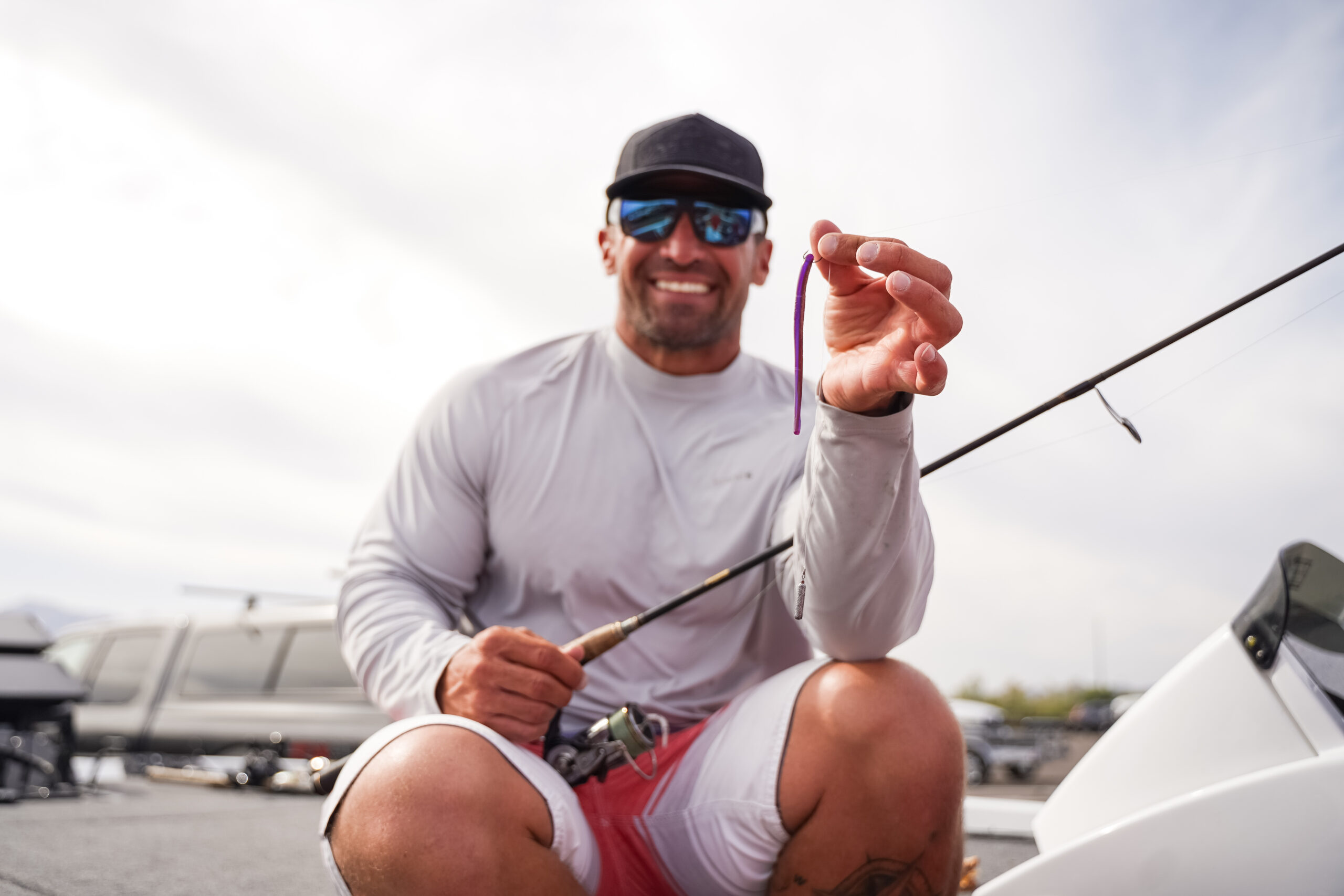
Michael Caruso planned to fish “super shallow” in the main lake with a glide bait, but that bite disappeared once competition began. He only caught one keeper on the glide on Day 1. Instead, he targeted areas that he felt were “off the beaten path,” most of which featured some kind of wood.
Caruso spotted a few fish on beds that he caught with a small, white tube. His primary bait, though, was a drop-shot with a 4.5-inch Roboworm straight tail worm in M.M. III. He estimated 80% of the fish he weighed ate the drop-shot, which he wielded on a Megabass Destroyer Addermine rod paired with a Daiwa Exist 3000 reel.
“I was targeting wood, either natural or sunken,” Caruso said. “And then I caught a couple fish that were key that were sight fish or fish that I had seen in practice moving around an area, and I ended up catching a few of them that way, that I knew they were in the area. Some I was physically looking at when I caught them in the tournament; other ones I was just fishing around the area and I caught the fish that were there swimming around.”
6. Miser power-fishes his way to sixth
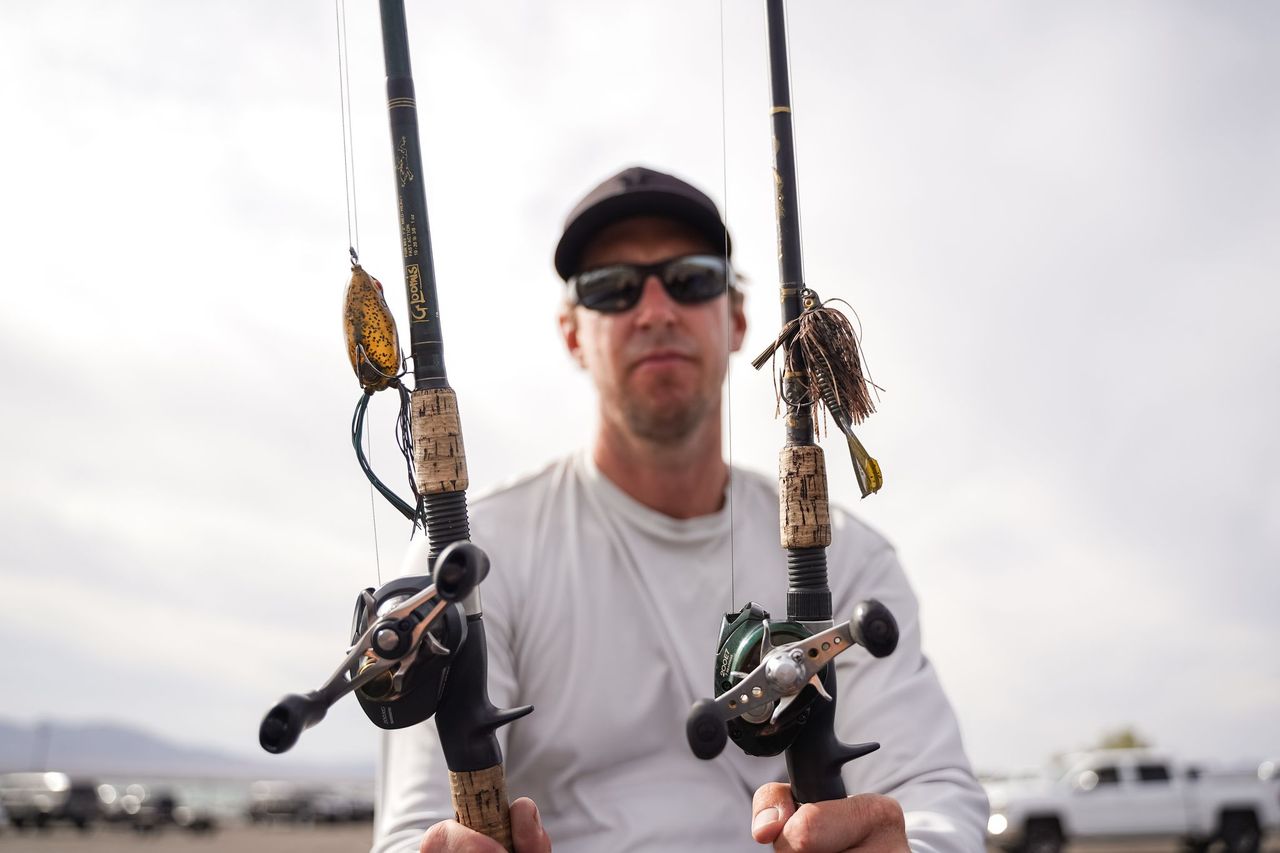
Greg Miser covered lots of water, fishing both the main lake and the riverine portion of the reservoir. Regardless of the area, he employed power tactics.
Miser started each morning targeting submerged grass with both a lipless crankbait and a Z-Man Evergreen Jack Hammer ChatterBait in the green shad color with a disco green Yamamoto Zako trailer. When that bite died, he ran even shallower and fished tules.
“After that little morning deal, I would put the boat super shallow and go flipping, go frogging and swim-jigging, dirt shallow,” Miser said. “It was real fun.”
For his frogging, Miser used a Spro Bronzeye 65 in green pumpkin. He also tossed a discontinued swim jig with a green pumpkin Strike King Rage Menace as a trailer and rotated through a handful of flipping baits. He used a mismatched assortment of rods and reels, noting that he caught at least a few keepers on a 20-year-old Daiwa Heartland rod (which has long since been discontinued) that he originally bought for $60.
7. Verbrugge rides brushpile bite
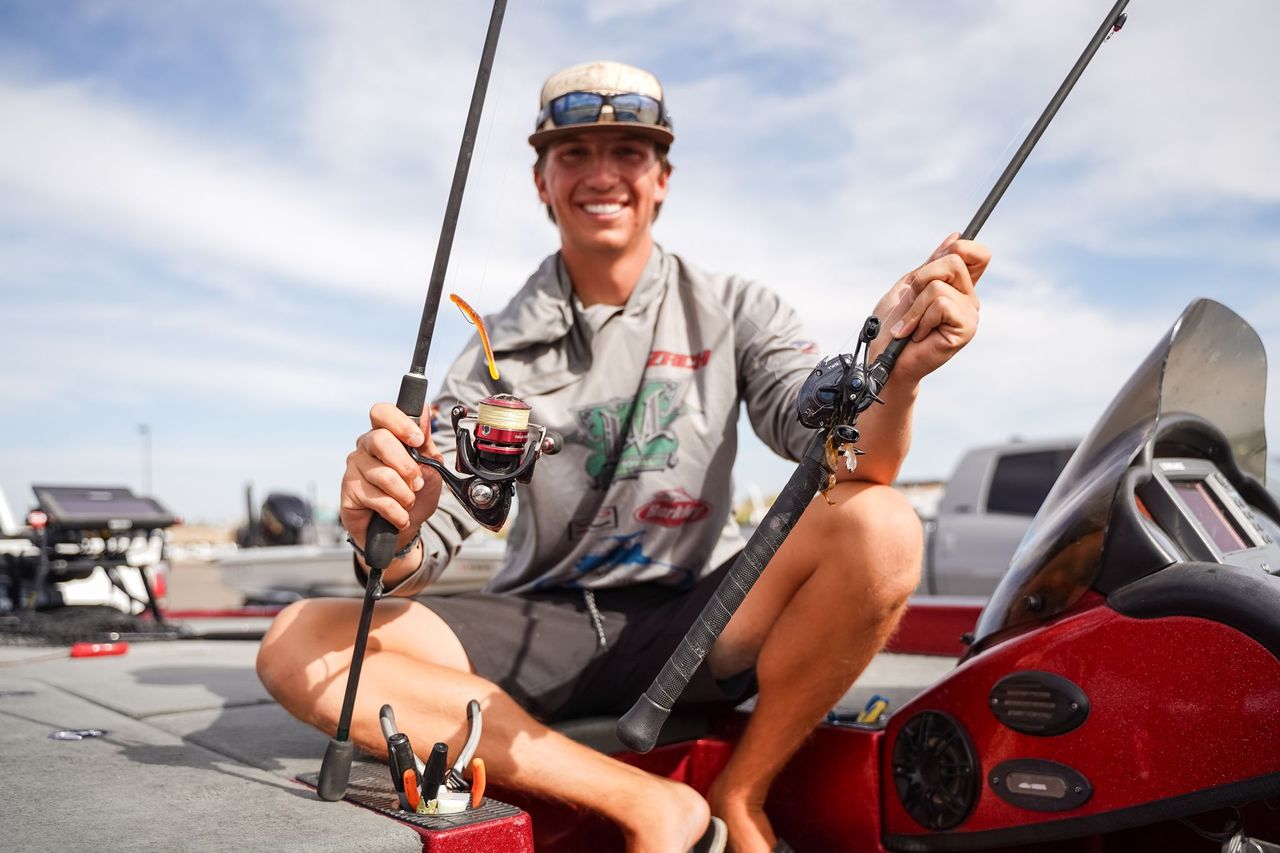
Zach Verbrugge celebrated his 20th birthday with a seventh-place finish and a paycheck on his home lake. Like many others in the Top 10, he got there by targeting postspawn largemouth around offshore habitat in the main lake, zeroing in on smaller brushpiles. The primary bait he used to target them was a finesse-y Carolina rig. Verbrugge used a 1/4- or 5/16-ounce Vivid Tungsten weight with about a foot-and-a-half of 10- or 12-pound test to a 3-inch Berkley Chigger Craw.
Interestingly, Verbrugge believes the bass were not only using the brushpiles to stage and recuperate after the spawn, but some were guarding fry. He could see the clouds of fry on his Garmin LiveScope, and in that case, he reached for a drop-shot. His rig consisted of a lemonade-colored finesse worm and a 1/4-ounce Vivid Tungsten weight on 7-pound fluorocarbon leader.
“I would use my LiveScope, my forward-facing sonar, to see (the brushpile), and then I would drag my Carolina Rig through it,” Verbrugge said. “And then if there was a fry-guarder, I could see the fry-guarders on my LiveScope, and that’s when I threw a drop-shot at them, to catch those fish.”
8. Edgar uses one-two drop-shot punch

Shane Edgar sampled a little bit of everything Lake Havasu had to offer. Early in the event, he caught several key fish on an unnamed glide bait. He also caught a few each morning on a Lobina Rico topwater in ghost.
Eventually, he found his way to artificial habitat in 15 to 25 feet of water like many of the other top finishers.
“I was fishing kind of all over the place,” Edgar said. “But I would say main focus for most of my bites was that 15 to 25, throwing a drop-shot.”
He targeted those offshore fish with a pair of drop-shots on Daiwa Steez AGS rods. When casting at the cages or brushpiles, he used an Owner cover shot hook to rig his bait weedless, opting for a 7-1, medium Utility Player rod. If he spotted an individual fish on his forward-facing sonar, he would switch to a nose-hooked bait on a 7-1, medium-light Finesse Game Special.
In both instances, Edgar tied 15-pound braid to an 8-pound fluorocarbon leader. He utilized a couple of plastics — a 3.75-inch Curly Tail Minnow from Arizona Custom Baits in dusty craw and a 4.5-inch Roboworm curl tail worm in oxblood light red flake.
9. Kerr adjusts to water level
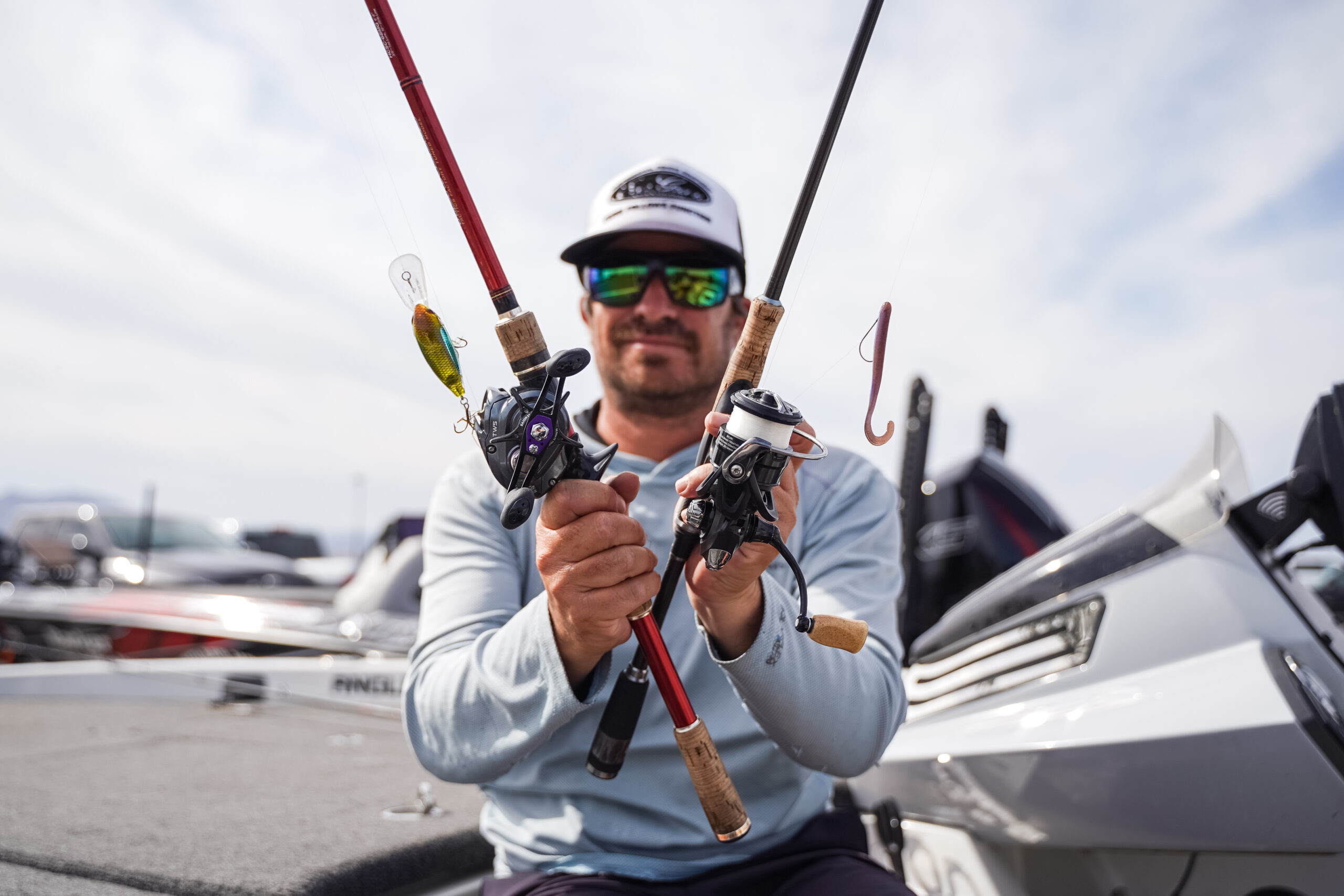
Justin Kerr started the event intent on fishing shallow in the river. He was able to pitch and flip his way to a 16-pound bag on Day 1 before falling water levels forced him to scrap that game plan and head to the main lake.
“I changed pretty much every day because the water was dropping so much,” he said. “I had to bail out of the river, because it was just too low.”
In the lake, Kerr utilized both a crankbait and a drop-shot. He threw an Evergreen CR-16 plug and a 4.5-inch Roboworm curl tail worm in oxblood on the drop-shot, using Evergreen rods and Daiwa reels for both applications.
10. Bonjour succeeds at both extremes
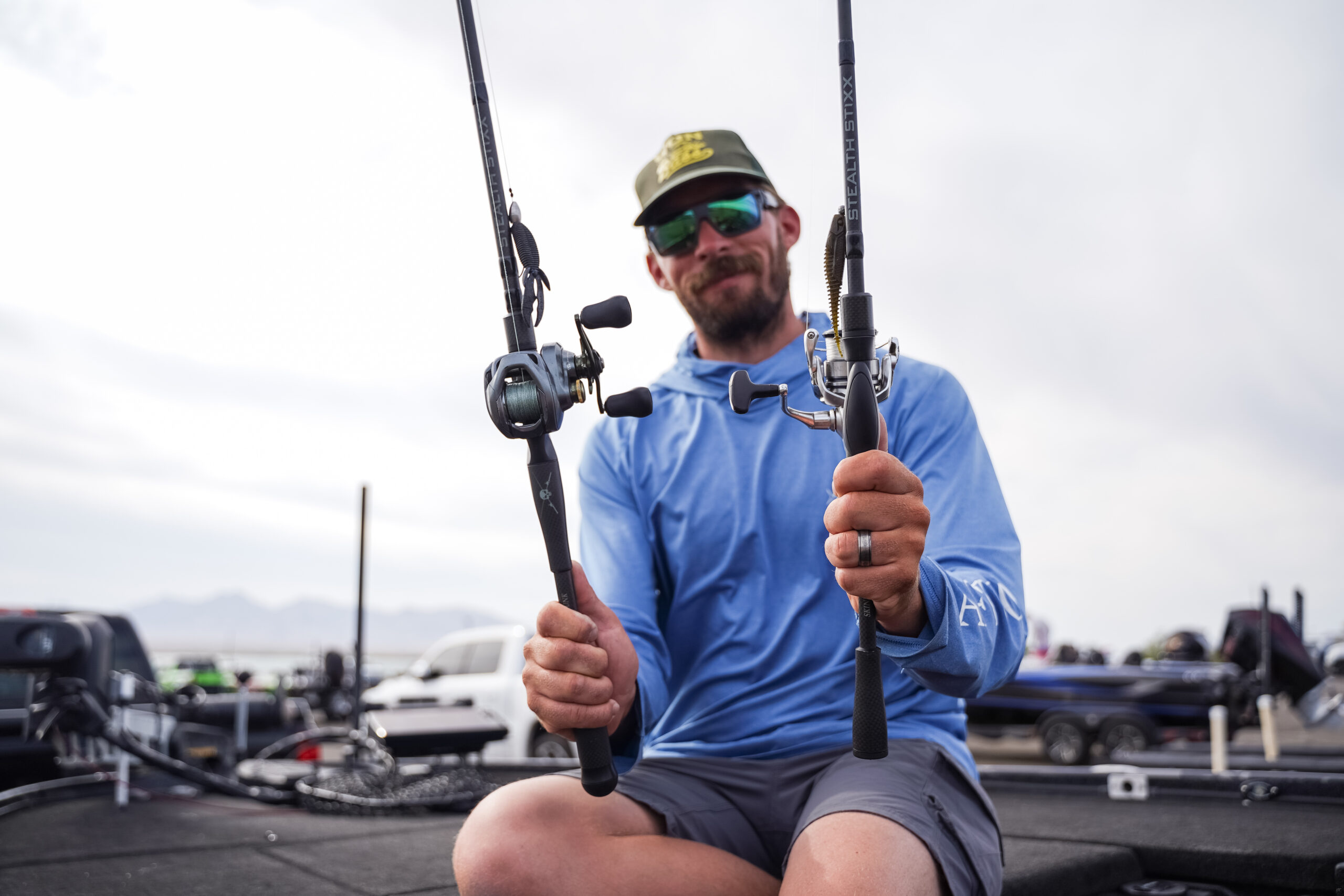
Fresh off a WON Bass win on Clear Lake, Austin Bonjour had to travel quite a bit farther from home but found himself back in the Top 10 at Havasu. He got there by plumbing a wide range of depths with an array of baits.
“I was catching fish anywhere from 1 foot of water out to 18-foot of water, and I used a lot of different techniques,” Bonjour said.
Bonjour started the event bed fishing in the shallows. He flipped a Berkley PowerBait MaxScent Creature Hawg both to fish he could see guarding beds and to likely pieces of cover. As the event progressed, he ventured deeper, swapping his casting rods for spinning gear.
He used a drop-shot and a jighead minnow to target fish that he spotted on forward-facing sonar. His drop-shot bait of choice was a 6-inch Roboworm straight tail worm in the people’s worm color, which he hooked wacky style. He threw a variety of soft-plastic minnows but mainly relied on a Rapala CrushCity Freeloader, which he affixed to both 1/16- and 1/8-ounce heads.
Bonjour used Stealth Stixx rods, opting for the Pillager model (7-5, heavy) for his flipping and both the Lil Pete (7-1, medium-light) and Skinny Pete (7-2, medium) for his spinning rod applications. He used Seaguar Smackdown braid to flip and as his main line on the spinning setups, attaching Seaguar Tatsu fluorocarbon leaders.